When you visit Destin and the Emerald Coast, you will notice there is a colored flag flying at the beach each day. This post will help you understand the Beach Flag Warning System so you know when it’s safe to be in the water.
These colored flags at the beach serve as a visual communication system to convey important information and warnings to beachgoers. The colored flags are used to provide quick and easily understandable messages about water and beach conditions, ensuring the safety of visitors.
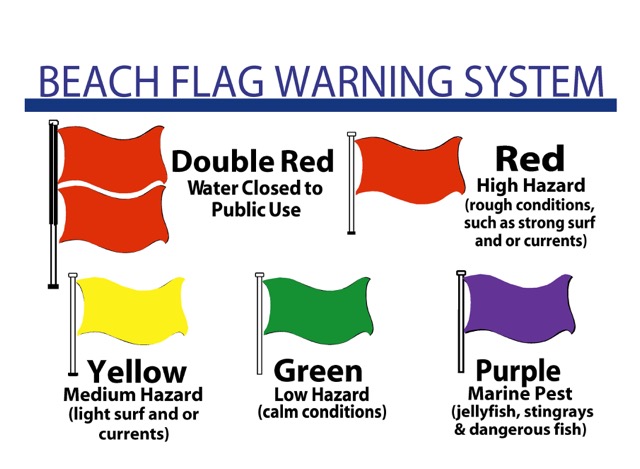
Colored Beach Flag Meanings
These colored flag systems provide a standardized and easily recognizable way for lifeguards, beach authorities, and visitors to communicate and understand the current conditions at the beach. By paying attention to the Beach Flag Warning System and following their instructions, individuals can make informed decisions regarding their activities and ensure a safer and more enjoyable beach experience.
Below are details about the meanings of each color beach flag:
Green Flag
A green flag at the beach typically signifies favorable or safe conditions. It indicates that the water and beach are generally considered safe for swimming and other recreational activities.
When a green flag is raised, it means that there are no significant hazards present, such as strong currents, high surf, or dangerous marine life. It is a positive indicator that encourages beachgoers to enjoy the water and participate in water-based activities with a lower risk of potential dangers.
However, even with a green flag, it is still important to exercise caution and follow general safety guidelines. It’s a good practice to swim in designated areas supervised by lifeguards, be mindful of your swimming abilities, and always be aware of changing conditions that may arise during your time at the beach.
Yellow Flag
A yellow flag at the beach typically signifies cautionary conditions. It indicates that there may be potential hazards in the water or on the beach that require beachgoers to exercise increased awareness and take necessary precautions.
When a yellow flag is raised, it is important to be mindful of your surroundings and take appropriate measures to ensure your safety. This may involve staying close to shore, avoiding strong currents or deep water, following lifeguard instructions, wearing sunscreen, and being aware of any specific warnings or guidelines provided by beach authorities.
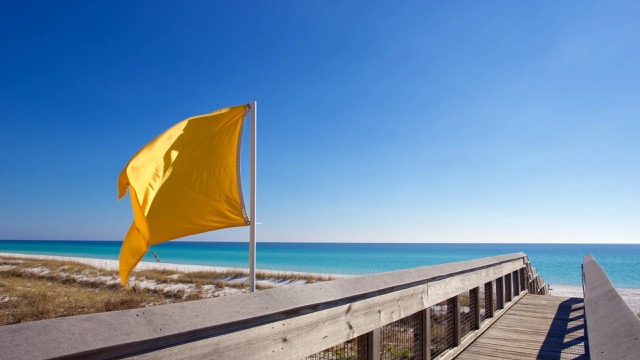
Single Red Flag
A single red flag at the beach is a warning sign indicating potentially hazardous conditions. While it may not indicate a complete closure of the water like double red flags, it serves as a cautionary symbol to beachgoers.
Common reasons for a single red flag include rough to moderate surf, stronger currents, or other conditions that may pose some danger to swimmers. While swimming may still be allowed under a single red flag, it is essential to exercise caution and pay attention to any additional instructions or warnings provided by lifeguards or beach authorities.
For inexperienced or novice swimmers, the saying for red flags is “Knee deep is too deep”. Even strong swimmers should exercise extreme caution if they decide to enter the water with a red flag flying.
Double Red Flags
Double red flags at the beach typically indicate extremely hazardous conditions and the closure of the water to the public. Double red flags signal that swimming is prohibited due to dangerous conditions. These conditions can include strong currents, high surf, rough waves, rip currents, or other factors that pose a significant risk to swimmers’ safety. It is important to respect and adhere to these warnings to prevent accidents and ensure the well-being of yourself, lifeguards, and first responders.
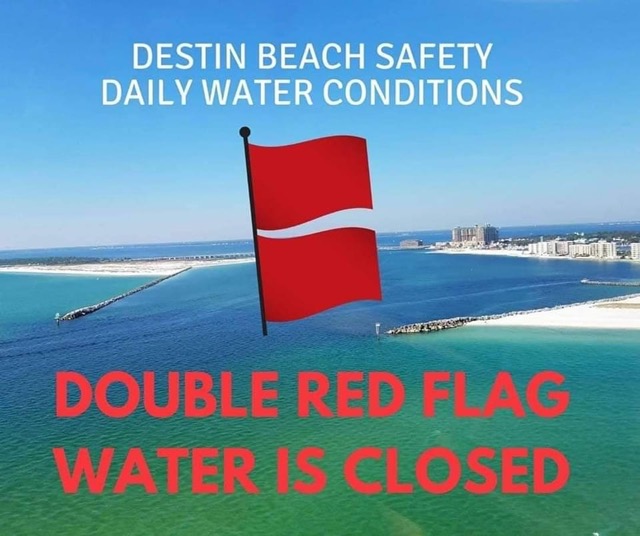
Purple Flags
The meaning of a purple flag at the beach is to signify dangerous marine life, particularly jellyfish. It serves as a warning to beachgoers about the presence of jellyfish or other potentially harmful marine creatures in the water or on the beach.
When a purple flag is raised, it is important to exercise caution and be aware of the potential risks. Jellyfish can deliver painful stings, and some species may have more severe effects on individuals who are allergic or sensitive to their venom. It is advisable to avoid swimming in areas where purple flags are flying if you are sensitive to stings, and to follow any additional instructions or guidance from lifeguards or beach authorities.
Rip Currents at the Beach
The main reason for the Beach Flag Warning System, is to keep you safe from rip currents at the beach. Rip currents, often referred to as rip tides or undertows, are powerful and fast-moving channels of water that flow away from the shore and out into the open sea. They typically form when water that has been pushed onto the beach by waves needs to find a way to return back to the ocean. As a result, it creates a concentrated flow of water that moves perpendicular to the shoreline.
Rip currents can be dangerous because they can pull swimmers away from the shore and into deeper water. They are one of the leading causes of lifeguard rescues and drowning incidents at the beach. It is important to note that rip currents are not visible from the surface and can occur at any beach with breaking waves.
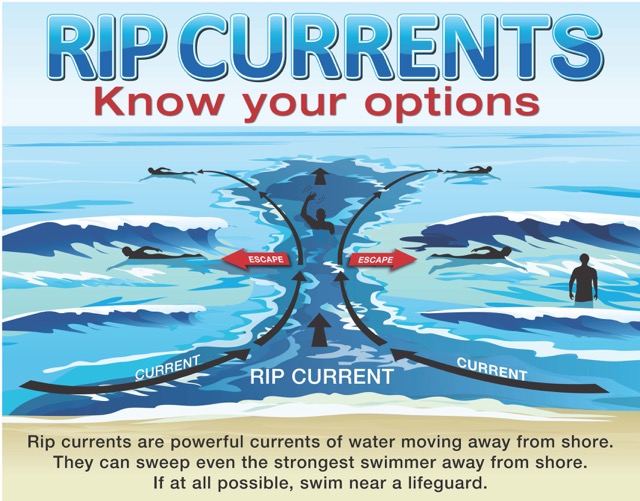
Here are some key characteristics of rip currents:
- Appearance: Rip currents may appear as darker, choppier, or foam-filled channels in the water compared to the surrounding areas.
- Location: They often occur in areas where there are breaks in sandbars, near jetties, piers, or other structures. They can also form around areas with deeper channels or where waves are breaking unevenly.
- Strength: Rip currents can be strong, reaching speeds of up to 8 feet per second, which is faster than most swimmers can swim.
- Width and Duration: Rip currents can vary in width, from just a few feet to several hundred feet. They can also change in size and intensity over time.
What to do if you are caught in a Rip Current at the Beach
If you find yourself caught in a rip current, it’s important to remember the following:
- Stay calm and avoid panicking.
- Do not try to swim directly back to shore against the current; it can exhaust you.
- Swim parallel to the shoreline until you are out of the rip current, and then swim at an angle back to the shore.
- If you are unable to swim out of the rip current, float or tread water and wave for assistance.
It is crucial to be aware of the potential presence of rip currents when visiting the beach and to follow any instructions or warnings from lifeguards or beach authorities regarding their conditions.
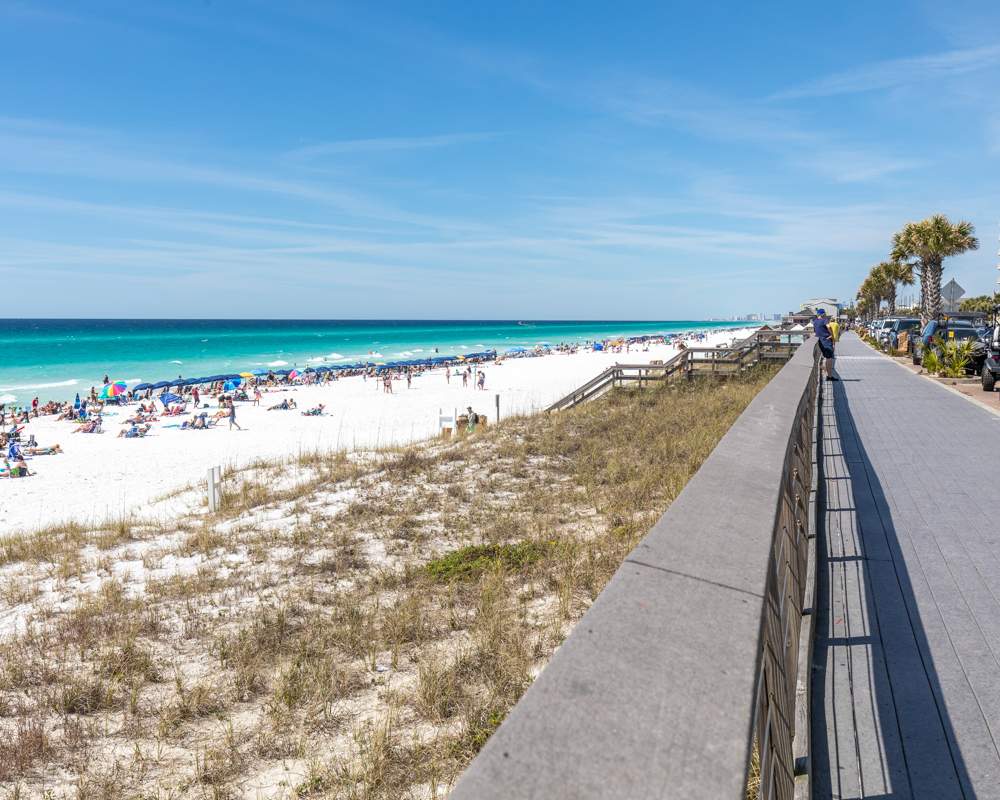
We hope this guide helps you with knowing how to have a fun and safe trip to the beach in Destin. Remember that the Beach Flag Warning System is designed to help you make informed decisions about your activities at the beach and to ensure the well-being of all beachgoers. It is essential to respect and adhere to these warnings to minimize risks and enjoy a safe beach experience. Follow the Destin Beach Safety Facebook Page for daily updates on beach flag colors and beach conditions in Destin.
If you want to have the best adventures on the beautiful water of Destin, Florida, be sure to book your excursions with us at Pelican Adventures. We have fishing, parasailing and snorkeling to choose from or why not try all 3? Book Online or call us at 850-650-3825. We look forward to taking you out on the water!
